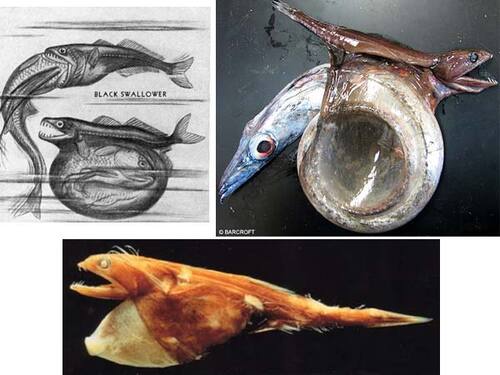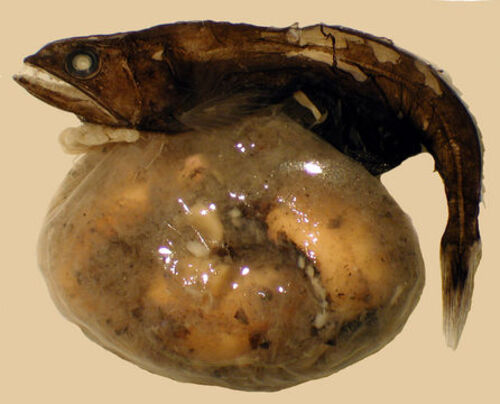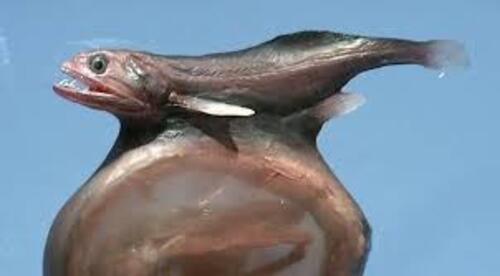When we think about competitive eating, we usually imagine human champions scarfing down hot dogs or pizza. But in the ocean’s deep, dark waters, there is a fish that would easily beat them all—the black swallower fish. This bizarre creature is nature’s ultimate competitive eater, capable of devouring prey many times its own size. Let's dive into why the black swallower fish truly earns its title as the king of competitive eating.
The black swallower (Chiasmodon niger) is a small deep-sea fish, typically around 25 cm (10 inches) long. It lives in the dark depths of the ocean, around 700 to 3,000 meters (2,300 to 9,800 feet) below the surface. At these depths, food can be hard to come by, which explains why the black swallower has developed such an extreme eating strategy.
Though it’s small, the black swallower is a voracious predator. Its dark, slender body helps it blend into the shadows of the deep sea, giving it the advantage of surprise when hunting prey.

The most impressive feature of the black swallower is its stomach. This fish has a unique ability to stretch and expand to an astonishing size, allowing it to swallow prey up to 10 times its own mass and twice its length. Imagine a human swallowing something the size of a car—that’s the kind of competitive eating we’re talking about!
Once it catches a fish, the black swallower uses its sharp teeth to grab hold of its meal and starts swallowing it whole. Unlike many predators that tear their prey into smaller pieces, the black swallower consumes its food in one massive gulp. Its stomach is so elastic that it can stretch to fit the meal, even if the prey is much larger than the fish itself.
The black swallower has a few special tricks up its sleeve that make its extreme eating possible:
Flexible Jaws: Its jaws can open much wider than most fish, allowing it to engulf large prey.
Expandable Stomach: The stomach is the star of the show, expanding to accommodate huge amounts of food.
Efficient Digestion: Once its stomach is full, the black swallower’s body gets to work breaking down the food as quickly as possible, so it can move on to its next meal.
For the black swallower, overeating isn’t just a metaphor—it’s a real danger. Because it can eat such large prey, there are times when the fish bites off more than it can chew, so to speak. If the prey is too large, the black swallower may not be able to digest it fast enough, and the meal starts to decompose inside its stomach. This can cause gas to build up in the fish’s body, making it float to the surface, where it often dies.
Scientists have discovered black swallowers washed ashore with their last meal still sticking out of their mouths, showing that even nature’s greatest eater sometimes has to pay the price for its gluttony.
What makes the black swallower stand out in the animal kingdom is its incredible ability to take on meals that seem impossible. In the competitive eating world, the rule is simple: whoever can eat the most, wins. By that standard, the black swallower is the undefeated champion. No other creature can eat such a large proportion of its body size in one sitting.
The black swallower’s eating habits also highlight the extreme survival tactics some deep-sea creatures have developed to cope with the harsh, food-scarce environment of the ocean depths. When food is hard to come by, you have to take what you can get—even if it’s ten times bigger than you.
The black swallower fish may not have the fame of competitive eating icons like Joey Chestnut or Takeru Kobayashi, but in the deep ocean, it’s the undisputed king. Its ability to devour prey that dwarfs its own size is a reminder of how bizarre and incredible nature can be. In the strange world of the deep sea, where survival often depends on getting the most out of every meal, the black swallower reigns supreme. So next time you see a hot dog eating contest, just remember: no matter how impressive those human eaters are, they’ve got nothing on the black swallower.

Black swallowers eat so much because of the extreme and challenging environment they live in—the deep ocean, where food is scarce and unpredictable. At depths of 700 to 3,000 meters (2,300 to 9,800 feet), prey can be difficult to find, so when an opportunity for a meal presents itself, the black swallower has to make the most of it.
Here are some key reasons why black swallowers have evolved to eat such large prey:
In the deep sea, food is not as abundant as in shallower waters. Prey might only pass by occasionally, and there may be long stretches of time between meals. By eating large prey in one go, the black swallower maximizes the energy and nutrients it can extract from a rare meal. This allows the fish to survive longer without having to find food frequently.
Catching and digesting a big meal is more energy-efficient than constantly hunting for small snacks. The black swallower's massive meals provide enough energy to sustain it for extended periods. This strategy helps the fish conserve energy, which is especially important in the deep sea, where swimming to chase down prey can be costly.
The black swallower has a "feast or famine" lifestyle. Because it never knows when the next meal will come, it has developed the ability to swallow prey much larger than itself. This way, whenever it encounters a meal, it can take full advantage and not waste the opportunity, even if the prey is far larger than it would normally be able to handle.
Living in the deep ocean presents unique challenges—it's cold, dark, and high pressure, with limited food sources. To survive, the black swallower needs to pack in as many calories as possible during feeding opportunities. Its expandable stomach and flexible jaws are adaptations that allow it to take in large amounts of food at once, helping it endure the harsh conditions of its habitat.
By eating large prey, the black swallower can reduce the need to constantly search for food, which limits the risks of encountering predators or wasting energy on unsuccessful hunts. In a deep-sea environment, fewer hunting trips mean a greater chance of survival.
In essence, black swallowers eat so much as an evolutionary response to the challenges of their environment. When food is rare, the best strategy is to eat as much as possible when the opportunity arises, even if that means swallowing a meal much bigger than themselves!
black swallowers primarily eat fish. Their diet mainly consists of bony fish, which they swallow whole. What makes them unique is their ability to consume prey that is much larger than themselves, sometimes up to 10 times their own mass and twice their length.
These fish typically target other fish that live in the deep ocean, where prey is scarce. Their expandable stomach and wide, flexible jaws allow them to capture and swallow these large fish in a single gulp. This strategy helps the black swallower take full advantage of any feeding opportunity that comes its way in the food-limited environment of the deep sea.
Some of the fish they are known to consume include lanternfish, which are common in the deep ocean, but they’ll eat any suitable fish they can catch.
A black swallower (Chiasmodon niger) primarily eats bony fish, which are often much larger than itself. These prey fish typically live in the deep sea, the same environment where the black swallower is found. Some common types of prey include:
Lanternfish – Small, deep-sea fish that are common in the dark ocean depths.
Other Deep-Sea Fish – The black swallower is an opportunistic predator, so it will consume various species of fish that are available in its environment.
What makes the black swallower unique is its ability to devour prey that is up to 10 times its own mass and twice its length. It uses its sharp teeth and incredibly expandable stomach to swallow these large fish whole, even if they are significantly bigger than itself. The fish doesn't tear its prey apart but instead gulps it down in one large meal, allowing it to store enough energy to survive in the scarce food environment of the deep ocean.

The Black Swallower fish (Chiasmodon niger) is a fascinating and mysterious creature living in the deep ocean. Known for its eerie appearance and unbelievable feeding habits, it has captured the curiosity of scientists and ocean enthusiasts. Let’s dive into 19 intriguing facts about the Black Swallower and uncover some of its remarkable traits and behaviors.
Black Swallowers are perfectly built for life in the deep sea. Their bodies are specially designed to survive extreme conditions, including freezing temperatures and crushing pressure, making them well-suited to the dark, abyssal depths.
These fish are usually found at depths between 2,000 and 10,000 feet (600 to 3,000 meters), where sunlight doesn’t reach, and the ocean is pitch-black. They roam these deep, dark waters in search of prey.
The Black Swallower has a long, slender body and dark, almost black coloration, which gives it a spooky, stealthy look. This helps it blend into its environment, making it hard for both predators and prey to see it.
Even though they’re typically only about 9 to 10 inches long (around 25 cm), their ability to eat prey much larger than themselves is jaw-dropping.
One of the Black Swallower’s most famous traits is its massive appetite. Its stomach can stretch dramatically, allowing it to gulp down prey much bigger than its own body size—sometimes 2 to 10 times its mass!
Instead of chasing after prey, Black Swallowers use a sit-and-wait strategy. They remain still in the water, waiting for an unsuspecting fish to swim by before quickly swallowing it whole.
After eating such large meals, digesting them can be a challenge. Due to their slow metabolism, it takes a long time for their bodies to break down food, meaning they don’t need to eat very often.
Their stretchy stomach is one of their most extraordinary features. It expands to hold prey that can be as much as twice their own size, and over time, their stomach shrinks back down as the food is digested.
The Black Swallower primarily feasts on other deep-sea creatures like lanternfish, eels, and squid. Their large appetite lets them take advantage of whatever food they can find.
Life in the deep sea has shaped their metabolism. It’s incredibly slow, which is a helpful adaptation in a place where food is scarce. This means they can go long periods between meals without starving.
Some Black Swallowers have glowing, bioluminescent organs that help them attract prey. These lights draw in curious creatures, making them easier to catch.
To navigate the dark, deep sea, Black Swallowers have highly sensitive eyes. These help them detect even the smallest movements in the inky black waters, giving them an edge when hunting.
As they eat prey larger than themselves, their body has to adjust. Their bladder expands to balance the weight of their meal, keeping them from sinking or floating uncontrollably.
Little is known about the migratory patterns of Black Swallowers. Some scientists believe they might move to shallower depths during certain times of the year, but more research is needed to confirm this.
Because of their deep-sea habitat, Black Swallowers are rarely encountered by humans. When they are found, it’s a special opportunity for scientists to study their unique behaviors.
The Black Swallower fish was first officially described by Carl Linnaeus, the Swedish scientist known as the father of modern taxonomy. Since then, scientists have been learning more about this species.
Studying creatures like the Black Swallower helps scientists understand the extreme conditions of the deep sea. It also reveals the fascinating adaptations that enable life in such harsh environments.
Though little is known about their population size, Black Swallowers are potentially threatened by human activities like deep-sea fishing and climate change. Protecting deep-sea ecosystems is crucial for their survival.
Research on Black Swallowers and other deep-sea species continues to uncover new insights. Each discovery helps expand our understanding of these mysterious fish and their hidden world.
The Black Swallower is truly a marvel of the deep ocean, with its ability to thrive in extreme environments and consume prey far larger than itself. This fish remains a subject of fascination for scientists as they explore the depths to unlock its secrets. By studying species like the Black Swallower, we gain a greater appreciation for the strange and wonderful creatures that live in the darkest parts of our planet.
animal tags: Black-Swallower
We created this article in conjunction with AI technology, then made sure it was fact-checked and edited by a Animals Top editor.